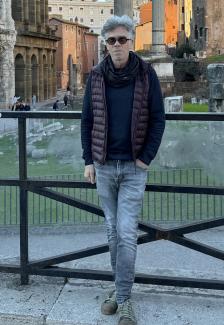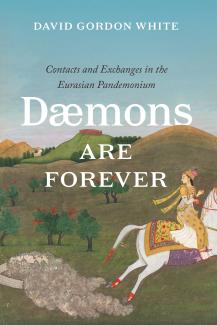
Distinguished Emeritus Professor of Religious Studies
HSSB 3077
Ph.D., The University of Chicago
Area
South Asian Religions; Connected Histories of Eurasian Religions
About

In my most recent book (Dæmons Are Forever: Contacts and Exchanges in the Eurasian Pandemonium (2021), I returned to the focus of my PhD dissertation and first book, Myths of the Dog-Man (1991). While the former project focused on the spread of the mytheme of a particular monstrous race across ancient and medieval Asia and Europe, Dæmons Are Forever focused on contacts and exchanges in matters of demonology. Unbound by exclusivist doctrinal and institutional strictures, the angelic and demonic divinities of “lower mythology” have traveled more lightly than gods, and so it is that one finds the names of Buddhist demons in medieval Manichean spell texts, charms against Iranian demons in Lithuanian and Chinese sources, an amulet of an Indian demoness at an archeological site in Turkmenistan, and so on. Elsewhere, the yoginis and dakinis of South and East Asian Hinduism and Buddhism find their Indo-European cousins in the Strigæ of ancient Rome and the vampires of early modern eastern Europe; the tenth-century BCE Homeric myth of Odysseus and Circe reappears, only slightly altered, in the Mahavamsa, a fifth-century CE chronicle of the island of Ceylon; and medieval mercury extraction accounts from the Sanskrit-language alchemical literature have their origins in the archaic Indo-European mytheme of “Fire in Water.” It is the “connected histories” of these beings and the humans who trafficked in them that remain my current area of focus. Both the Silk Road and ancient and medieval maritime trade routes were information superhighways, and a portion of that information was demonological. It is easy to imagine soldiers, sailors, merchants, diviners, monks, and priests swapping amulets and spells at Silk Road halting points and ports. Demons and the techniques to control them were as much a commodity in the ancient and medieval world as germs, guns, and steel. Other of my recent and current projects focus on the mythology and iconography of the Indo-European hero, translations of Sanskrit tantric and alchemical texts, tree worship in India, and Dracula’s family tree.
Publications
- Dæmons Are Forever: Contacts and Exchanges in the Eurasian Pandemonium (University of Chicago Press, 2021).
- The Yoga Sutra of Patañjali. A Biography (Princeton University Press, 2015). Virtually forgotten in India for hundreds of years and maligned when it was first discovered in the west, the Yoga Sutra of Patanjali now enjoys the status of multicultural icon. David Gordon White tells the story of the rise, fall, and modern-day resurgence of an enigmatic text whose readers have included some of the most colorful culture brokers in history.
- Yoga in Practice (Princeton University Press, 2011).
- Sinister Yogis (University of Chicago Press, 2009). In this book, I rewrite the history of yoga by focusing on 2000 years of representations of the yogic actors known as yogis. Sinister Yogis is the final work (but chronologically the first work) in a trilogy on medieval Indic traditions whose goals were bodily immortality and supernatural powers.
- Kiss of the Yogini: “Tantric Sex” in its South Asian Contexts (University of Chicago Press, 2003). It was ritual transactions in sexual fluids between human practitioners and superhuman female beings called Yoginis that gave Tantra its specificity in medieval South Asian religions.
- Tantra in Practice (Princeton University Press, 2000). I am the editor of this volume, as well as the author of its introductory essay, “Tantra in Practice: Mapping a Tradition.”
- The Alchemical Body: Siddha Traditions in Medieval India (University of Chicago Press, 1996). Between the tenth and fourteenth centuries, the alchemical, hathayogic and erotico-mystical practices of religious sects and orders who called themselves Siddhas were mutually informing.
Articles
- "Apotheosis and Afterlife of the Indo-European Hero," in Encyclopedia of Transcendence and Transformation (online publication) (Harvard University Press 2025).
- "The Practice of Alchemy and the Initiation of the Alchemical Practitioner: Chapters One and Two of the Rasārṇavam,” in Dagmar Wujastyk and Patricia Sauthoff, eds., Indian Alchemy--Sources and Contexts (New York: Oxford University Press, 2025), pp. 49-85.
- “Arbres-déesses dans la Forêt de la Félicité,” in Tiziana Leucci and Julien Jugand, eds., Mémoire de Bénarès: Territoires, religiosités, controverses (Puruṣārtha 40) (Paris: Editions de l’EHESS, 2025), pp. 45-73.
- "Demonology," Aeon Magazine, May 12, 2025. https://aeon.co/essays/the-many-lives-of-eurasian-daimonology.
- “Three Shades of Tantric Yoga: Chapter 20 of the Netra Tantra,” in Glen Hayes and Richard Payne, eds., Oxford Handbook of Tantric Studies, (New York: Oxford University Press, 2024), pp. 369-93.
- "The Hero's Head in Indo-European Myth, Ritual, and Iconography," Rivista degli Studi Orientali 96.2-4 (2023), pp. 117-39.
- "Goddess Trees in the Forest of Bliss: Local Place and Translocal Space in a City of Pilgrims," in Aaron Ullrey and Sravana Borkataky-Varma, eds., Living Folk Religions. London: Routledge, 2023), pp. 89-112.
- “Dracula’s Family Tree: Demonology, Taxonomy, and Orientalist Influences in Bram Stoker’s Iconic Novel,” Gothic Studies 24.1 (March 2022), pp. 297-315.
Courses Taught
- RS 12 Religious Approaches to Death
- RS 136 Creation Myths
- RS 160 Religious Traditions in India
- RS 161D Alchemy, Yoga, and Tantra: Three Paths to Power in Medieval South Asia
- RS 169 Hindu Devotional Traditions
- Alchemy (Freshman Seminar)
- RS 206: Seminar in South Asian Religious Studies (topics include Hindu Epics, Hindu Tantra, Worship Without Devotion: History of South Asian Polytheism)
- Readings in Sanskrit: Netra Tantra, Brhannaradiya Purana, Mahabharata, Rasarnavam, Harivamsa, etc.